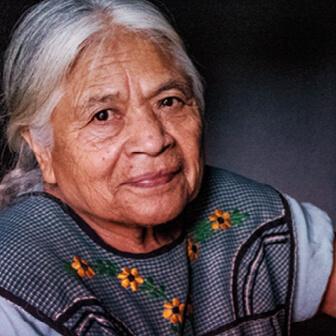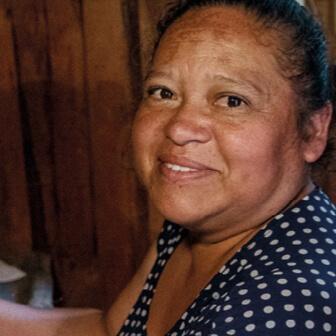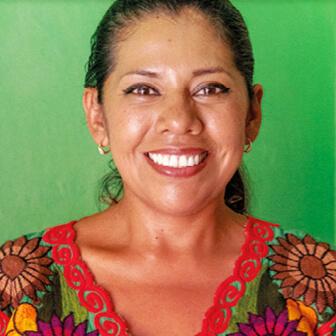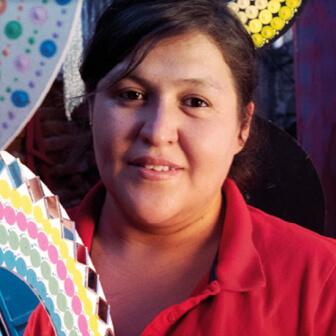Rethinking our Perspective: The Value of Craft within the Culture of the Traditional Art World
8 May, 2023
Blog, Press
On March 27, I was honored to participate in the event “The Female Entrepreneur in Latin American Art” at MAMAN Fine Art Gallery, an art space in Miami. The event brought together artists and critics from Latin America to discuss how culture and creativity can empower women, as well as possible solutions to address women’s underrepresentation in creative industries.
Following these conversations, I found myself reflecting on the multiple barriers that impact the lives of women who create art and how these barriers multiply for women who experience intersecting economic and/or ethnic discrimination. I immediately thought of the thousands of Latin American women who dedicate their lives to their craft and artistic creation and are negatively impacted by the cultural and economic undervaluation of their work.
Pro Mujer has given me the opportunity to personally meet and spend time with many of these women, to see how their remarkable work reflects their worldview, their culture, and their identity. I have been left completely awestruck by the complexity, technical difficulty, and beauty of the things they create by hand. And this led me to wonder why our society values art over craft.
Traditionally–and perhaps, incorrectly–when we think of art, we tend to think of the art forms that are most often found in museums and galleries, and we appreciate these works of art for their technique, originality, or aesthetics. This gives traditional art a more significant cultural, social, and economic value over handicrafts, which have always had a practical use in everyday social life.
However, many handcrafted pieces have an undeniable beauty and extraordinary technique. Textiles, ceramics, jewelry, woven baskets, and a seemingly endless list of other remarkable objects created by Latin American women, including one-of-a-kind pieces, are not given the same social and economic value assigned to pieces that are considered “art.”
Why is this? What are the reasons or characteristics that classify one aesthetic object as art and another as handicraft?
Although the distinction between art and craft isn’t so clear for some experts, others argue that it is based more on cultural perceptions than any intrinsic characteristics of the cultural product itself. In their book Makers: A History of American Studio Craft, Janet Koplos and Bruce Metcalf write: “Craft is a medium of cultural expression as powerful and worthy of attention as painting, sculpture, or architecture. However, crafts are often considered an inferior art form and overlooked in favor of more conventional art forms.”
It is important to note that both traditional art and handicrafts play an equally important role in preserving the culture and history of a community or culture. As noted by anthropologist Clifford Geertz in his 1983 essay “Art as a Cultural System,” “…art is a way of life, and, as such, it is a fundamental part of the culture of a people.” Following this definition, it can be argued that both art and craft have deep roots in history and tradition, are a core part of the culture and identity of a people, and, therefore, should be valued in the same way.
In terms of aesthetics, handicrafts are a manifestation of creativity that bring a unique aesthetic and technical richness that reflect the diversity and complexity of different cultures. They require technical and manual skills comparable to the skills needed to create traditional art and should be considered works of art in their own right. It is critical to rethink our perception of what is considered “beautiful” and worthy of our attention. This will allow us to broaden our horizons and appreciate beauty from less arbitrary and more enriching perspectives.
Historically, art has been associated with the elite and high culture, while craft has been related to the lower classes and the traditions of local cultures. Because of this, traditional art and handicrafts are clearly valued differently. This is detrimental to local artisans and jeopardizes the culture and history of a people, making it all the more important to rethink the social value of handicrafts as an expression and preservation of the identity of Indigenous peoples around the world.
Undoubtedly, the distinction between art and crafts results from the structural barriers, prejudices, and stereotypes that exist in our society and impact artisans and craftspeople.
A clear example is the constant plagiarism and appropriation of Indigenous designs and embroidery by high-end fashion brands. That these brands can take a handcrafted design, place it on a garment or product, and then sell it at exponentially higher prices in exclusive boutiques makes it clear that there is demand. Original artisans need resources and opportunities so that their work can be valued and recognized at the level it deserves.
Why is a rug woven in Teotitlán del Valle, Oaxaca, that took years of hard work to create—raising, tending, and shearing the sheep, carding and washing the wool, dying it, spinning it, and then weaving it into something beautiful–not considered a work of art in the same way that a painting is?
Although there are specific differences, and it is essential to recognize them, the most important thing is to recognize that the cultural, social, and aesthetic value provided by art and handicrafts are identical and that what truly distinguishes art from craft is the prevailing cultural perception based on the structural barriers that mark the distinction between artist and artisan. Fortunately, this perception can be changed. Little by little, the art and culture of Indigenous peoples have started to receive the respect and value they deserve.
These days, there are more and more spaces, works, and artists that push and encourage us to explore and question outdated assumptions about art and, even more importantly, that recognize, reclaim, and promote artistic expression as a powerful tool for women’s empowerment and advocacy. Galleries like MAMAN Fine Art Gallery are willing to open the conversation and break the myth that the value of an artisan’s work is inferior to art. I celebrate the commitment to starting this conversation and making the art world more inclusive.






